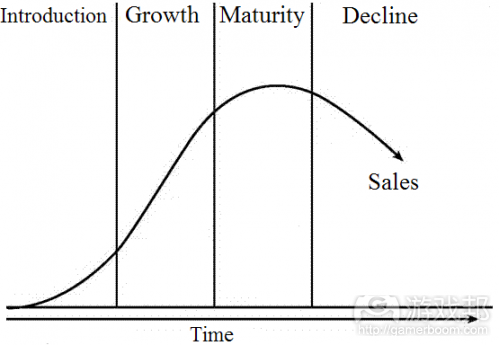未来iOS游戏开发所面临的经济挑战
游戏邦注:本文原作者是David Wesley,他在根据Game Developer Survey在去年的一项iPhone和iPad应用开发者调查结果,发表了自己对iOS应用开发所面临挑战的一些看法。原文发表于2010年7月,所涉数据及时间均以当时为准。
毋庸质疑,iPhone和iPad游戏的开发者数量正在逐渐增多。
尽管App Store无疑是上天对苹果的眷顾之物(游戏邦注:将来一段时间内依然会发展良好),但对开发者而言,他们有可能会落入一个陷阱。
从表面上来看,iPhone和iPad似乎是个游戏的理想平台。以iPhone为例,它有着:庞大的用户基础;持续成长的市场;易掌握且简单易用的开发工具;廉价的营销费用。
但是,出于同样的原因,iPhone也有可能为多数游戏开发者带来经济挑战。每款应用都有14万个竞争者,即便是最有创造性的程序都很难吸引潜在用户的注意。
据Gartner调查曾预测,2010年应用下载盈利预计达到62亿美元,到2013年将上升至290亿美元。问题在于,此类预测的前提是用户数和应用销售量能够呈线性增长。比如,根据上述得出的结论,2013年智能手机用户需要增加至逾3亿之众,而且平均每个用户每年需要消费与目前用户消费同等数量和金额的应用(游戏邦注:Gartner预计到那时2/3的智能手机应用的用户使用iPhone)。
这种假设上存在的问题是,它与基本经济模型相悖。
到目前为止,智能手机应用最大的来源是App Store,在2009年占应用总销量的99.4%。App Store中应用数量的增长会导致每款应用的可用性降低,从而导致在新应用出现时现有应用的价值全部下降。但是,社交网络的价值会随着用户数增加而提升,这与手机应用的状况恰恰相反。网络游戏社群需要用户数不断增长,这样方能保证玩家每时每刻都有对手与之对抗。
虽然这两种相反的状况很容易混淆,但认清其中的差异还是非常重要的。通常来说,系统拥有大批量的程序是很有益的,因为这会鼓励人们购买系统,而这反过来提示发行商投入更多资金资助特定平台的游戏开发。
在上图中,我们假设一款应用的开发成本保持不变,那么所有iPhone应用的总计成本都会因数量的增加而呈直线增长。在A点之前,网络效应可以为每款应用加分,而过了A点之后,每款应用获得的利润开始下降。当你达到B点时,推出新应用所获得的利润就开始低于成本。
以PS3为例,当它首次发布时,用户最主要批评的是主机的高价换来的却是极少的游戏(游戏邦注:尤其是专属游戏)。随着时间推移,PS3平台上出现了越来越多的游戏,于是良好的游戏开发循环就此显现出来。到目前为止,Xbox 360和PS3的开发还未达到上图中的B点。理想状况下,主机制造商会在交叉点出现以及开发商认为在某平台上开发游戏已不再有价值之前发布新平台。
事实上,逐渐减小的边际效用扮演着很重要的角色。Gartner假设当前用户会在2013年时继续购买同等数量的应用,据其所称:“今日的高端智能手机用户是首批认可新手机应用的人,他们也更能为计费机制所信赖。因而,他们会继续为自己认为有用的应用付费。”
然而,逐渐减小的边际效用显示,随着每款新增应用价值以及其满足用户特别需求的能力逐渐减少,用户购买的应用会越来越少。新iPhone用户首次从App Store中购买应用程序的目标是满足某种需求。第二次购买的应用或许也是为了满足需求,但应用的重要性可能已经有所下滑。随着时间推移,平均每个iPhone用户都购买了20款应用,那么每款新程序新增的价值或许都会显得微不足道。
尽管Gartner认为早期使用应用的人相比后期的用户来说对技术的应用更加稳定,他们忽略的事实是,iPhone将来的成长将逐渐倚重于后期的用户。扩散理论显示,早期使用应用的用户或者受过优良教育,或者有较高的社会地位,或者很富裕。然而,后期的用户可能并未受过教育、社会地位较低而且收入也较少。他们在购买新功能和应用时会更加犹豫不决,于是便会逐渐将注意力转向手机上预设的标准应用。
苹果以两种方式来应对这种挑战:营销扩展和平台重建。
通过不断为iPhone添加新功能,苹果吸引了那些认为这些功能很有价值并且希望能够长期使用的新用户。比如GPS导航等较为常见的功能以及乐器调音和远程开发等更为复杂的功能。
这种方法与任天堂在Wii上采取的措施极为相似。任天堂开始逐步改善现有的GameCube技术,并通过Wii Remote添加体感控制系统。该公司通过平衡板再次扩展市场,吸引了大量关心身体健康的新顾客。
第二种方法便是引进新平台来吸引更多早期的使用者。主机制造商每次发布新游戏硬件采取的便是这种做法,苹果的做法则是引进iPad。
iPad带来的需求可以帮助扩展App Store产品寿命循环的成长期。然而,相对iPhone而言,iPad的大小和价格最终会限制其市场诉求。这种状况带来的结果是,它无法支撑Gartner所预测的结果。
即便苹果成功利用iPad扩展市场并吸引新群体的用户,开发商仍然需要面对上文提到的逐渐较少的效用的问题。只有提供全新体验、用户所需重要功能以及受专利和版权保护的应用才能逃此劫难。
当iPad发布时,所设计应用满足以上三种条件的开发商获得成功的可能性最大。
质量与数量
回到上文所说的社交网络的例子,如果社交网络站点没有增加额外的服务器、网络开关和带宽来为用户大量增长提供支持,那么用户增长带来的联网效应也不再会产生效果。系统可能会在达到顶峰之后开始走下坡路,用户也会转而寻找其他的站点。用户个人对社交网络站点所做贡献的价值并不会影响到站点的整体状况,那些只知道灌水的用户对这些站点在线表现的影响与那些提供有价值内容的用户相同。和社交网络用户相同,任何应用的个体状况同样也无足轻重,因为产生影响的是用户的整体评价和观点。
以上是应用总数(蓝线)相对于下载量总数(红线)的对比图。这里的下载数量包括免费应用。
但是,应用数量的增多让iPhone用户感到无所适从,他们也受到苹果应用商店中那些低质量应用的影响。如果是这样的话,真正对商店整体表现产生影响的就是每个程序的效果而不是整体效果了。而这正是App Store与乐器模拟游戏最大的差别所在。《吉他英雄》和《Rock Band》的用户知道他们会得到一款精致的游戏,但iPhone用户发现自己正处在满是劣质应用的汪洋大海中。
但是,这不一定意味着iPhone用户会转而投向诺基亚的怀抱,就像社交网络用户不会因为无法访问流行站点,或站点上充斥着大量毫无意义的内容而放弃使用网络一样。上述状况所产生的影响是,App Store对iPhone用户的价值会降低,他们对那些开发公司花大量广告费用宣传的流行游戏,或好友及其他有影响力的人推荐的应用的购买力度也会受到影响。(本文为游戏邦/gamerboom.com编译,如需转载请联系:游戏邦)
The Economic Challenges (and opportunities) of Developing Games for the iPhone and iPad
David Wesley
According to a recent Game Developer Survey, increasing numbers of developers are working on games for the iPhone and iPad.
As shown from the results of the survey, another increasingly prevalent trend has been the growth of the mobile space. Due in large part to the success of Apple’s iPhone software platform, mobile support shot up to 25 percent of developers, more than doubling last year’s 12 percent.
Although the App Store has certainly been a godsend to Apple (and it will continue to be for some time), for developers it has the potential to become a trap.
On the surface, the iPhone and iPad would seem to be ideal platforms to develop games for. The iPhone, for example, has: A large install base; A growing market; Easy to learn and readily available development tools; Inexpensive distribution.
Yet, for those same reasons, the iPhone will prove to be an economic challenge for most game developers. With 140,000 apps to compete with, even the most creative programs will have a hard time attracting the notice of potential customers.
According to Gartner research, revenue from app downloads is expected to reach $6.2 billion in 2010, rising to over $29 billion by 2013. The problem is that such predictions often assume straight line growth, both in the number of users and in the average number of applications sold. For example, for those numbers to hold, the number of smartphone users would need to increase to over 300 million by 2013, and the average user would need to consume each year the same number of apps, at the same average cost, as current users consume (Gartner expects more than 2/3 of these smartphone app consumers to be iPhone owners).
The problem with those assumptions is that they contradict basic economic models.
By far, the largest source of smartphone apps is the App Store, accounting for 99.4% of sales in 2009. Whenever an application is approved for the App Store, it diminishes the value of all the existing apps by reducing their individual utility. In a sense, it is the inverse of the network effects that accrue to a social networking site as more people become members. Online gaming communities, for example, depend on membership growth to ensure that gamers have opponents to play against at any given hour of the day.
Although these two opposing forces are easy to confuse, it is important to recognize their differences. Normally, having large numbers of programs available on a system is positive because it encourages people to buy more systems, which in turn gives a signal to publishers to fund more game development on a particular platform.
Consider the PlayStation 3. When it was first launched, one of the main criticisms was the lack of games (particularly exclusively titles) to justify the console’s high cost relative to the Xbox 360. Over time, as more games became available for the PS3, a virtuous cycle developed that helped to increase the pace of development. So far, Xbox 360 and PS3 development has not yet reached the crossover point represented by point B in the above graph. Ideally, console makers will introduce a new platform before the crossover point is reached and before developers decide that a platform is no longer worth developing games for.
In fact, diminishing marginal utility has an important role to play in both cases. Gartner assumes that current users will continue to purchase the same number of applications each year through 2013, telling Information Week that “high-end smartphone users today are early adopters of new mobile applications and are more trustful of billing mechanisms… Therefore, they are expected to continue to pay for applications they believe will be useful.”
However, diminishing marginal utility suggests that users will purchase fewer applications over time as the value of each additional application and its ability to meet the particular needs of the user decreases. A new iPhone owner who purchases a software program from the App Store will first purchase the application that most fills a perceived need. The second application will also fill a need, but most likely it will be a less important one, and so on. By the time the average iPhone user has purchased 20 applications, the value added by each new program will be marginal at best.
Although Gartner recognizes that early adopters are heavier users of technology than late adopters, they ignore the fact that iPhone’s future growth will increasingly shift toward late adopters. Diffusion theory suggests that early adopters tend to be educated, have higher social status, and are wealthy. On the other end of the spectrum, late adopters tend to be less educated, have lower social status and have less income. They will be more skeptical about adding new features and applications, and will instead rely upon standard applications that come preloaded with the phone.
Apple has responded to this challenge in two ways, through market expansion and platform renewal.
By continually adding new features to the iPhone, Apple has attracted new users who value these features and are willing to enter into long term contracts to obtain them. Examples range from commonly found features like GPS navigation to more esoteric features like instrument tuning and remote invoicing.
This approach is very similar to the one taken by Nintendo with the Wii. Nintendo began by improving existing GameCube technology and adding motion control through the Wii Remote. It expanded the market again with the balance board, which attracted a new group of customers who were fundamentally concerned about fitness.
The other option is to introduce a new platform to attract more early adopters. Console makers do this every time they introduce a new generation of gaming hardware, and Apple is doing it with the introduction of the iPad.
Initial demand for the iPad could help to extend the growth stage of the App Store’s product life cycle. Ultimately, however, the iPad’s size and price will limit its market appeal relative to the iPhone. As a result, it will not provide the type of renewal that will support the growth rates projected by Gartner.
Even if Apple successfully expands the market and attracts a new group of early adopters with the iPad, developers will still need to contend with the diminishing utility problem discussed earlier. The only exceptions will be applications that offer fundamentally new experiences; fulfill important functions that consumers value; and can be protected from similar programs through patents and copyright.
When the iPad is released, early movers who can design applications that fit all three criteria will have the best chance of success.
Quality versus Quantity
Returning to the social networking example, the network effect of adding more members would no longer be valid if the social networking site did not add additional servers, network switches, and bandwidth to compensate for the added burden. Instead, the system would begin to crash during times of peak activity and members would begin to turn to alternative sites. The value of any individual member’s contribution to a social networking site does not matter to the site’s overall performance. Users who fill discussion boards with gibberish impact online performance on these sites as much as users who contribute valuable content. Like the social networking user, the individual role of any given application does not matter, because it is the aggregate that determines overall performance from the point of view of the consumer.
At the same time that iPhone owners are becoming overwhelming by the number of applications, they are also impacted by the number of lower quality applications that Apple allows to be sold through its store. In this case, it is the individual effect of each program rather than the aggregate that matters. And this is where the App Store differs most from instrument simulation games. Consumers of Guitar Hero and Rock Band know they are going to receive a polished product, whereas iPhone users are left to wade through a sea of poorly thought out applications.
That does not necessarily mean that iPhone owners will be switching to Nokia any more than social networking users will stop using the Internet because of an inability to access a popular site, or because the site has become polluted with unmoderated nonsense. It does mean that the App Store will hold less value to iPhone owners, who will increasingly limit their purchases to popular titles from companies with large advertising budgets or apps that have been recommended by friends, TV personalities, and other influential people. (Source: Gamasutra)











































 闽公网安备35020302001549号
闽公网安备35020302001549号